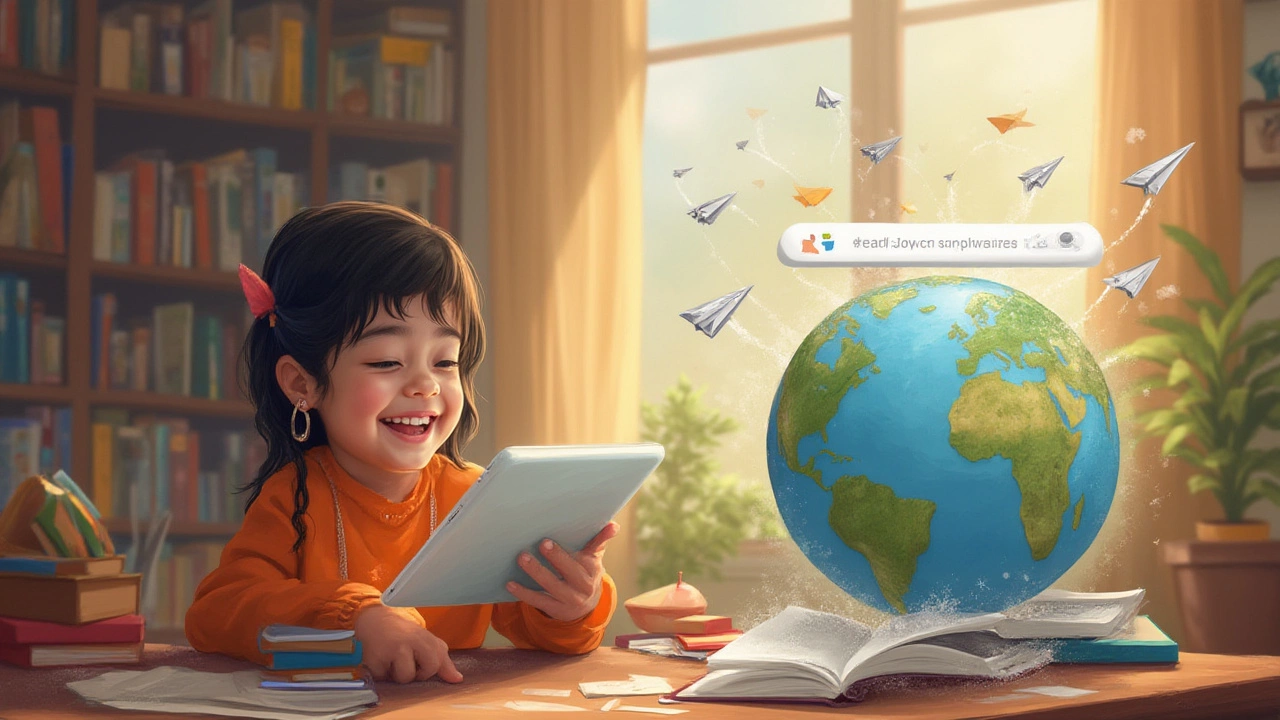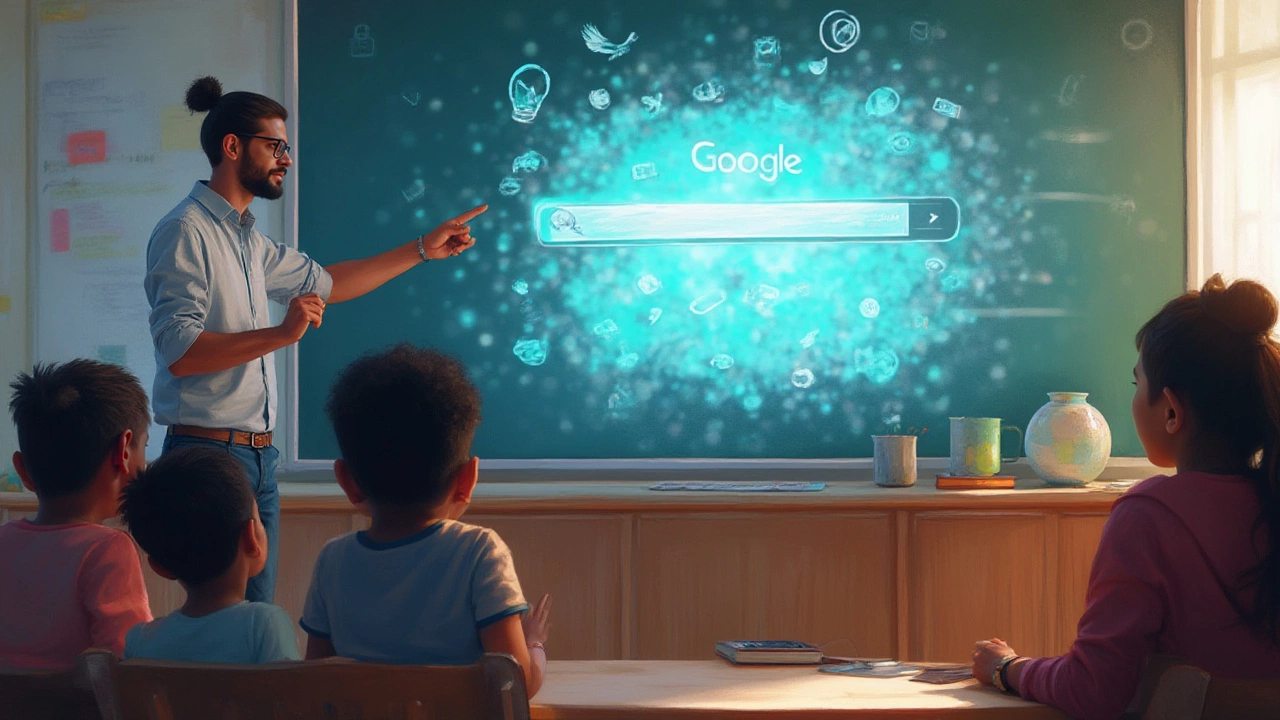Type almost anything into that white search bar, and like magic, Google dishes out an answer in less than a second. But here's the question—has Google become too useful? Is it just a search engine, or has it actually turned into an e-learning platform, quietly teaching billions each day without us giving it any thought? This idea isn't as wild as it sounds. People use Google not just to look up movie times or pizza places nearby, but to actually learn skills, prep for exams, study complicated theories, and even take their first steps toward a new career—all without ever paying a dime for an official course.
Where Google Sits in the E-Learning World
Let's break it down. E-learning platforms like Coursera, Udemy, or Khan Academy are built with structured courses, quizzes, and lesson plans. On the surface, Google is missing these. But look closer and you'll see Google is everywhere in digital education. Start with Google Search: it's not just a portal to Wikipedia. It's stacked with features designed to educate—quick facts, step-by-step instructions, interactive graphs, and knowledge cards. How many times have you typed in something like 'how to change a tire' or 'photosynthesis explained'? Immediate learning, no class required.
Then there's Google Scholar. Unlike regular search, it filters out the noise and brings you straight to academic research, journal articles, patents, even court opinions. It's a goldmine for students, researchers, and lifelong learners who want sources they can trust. The sheer scope is staggering: Google Scholar indexes over 389 million documents. No other free tool comes close.
Don't forget YouTube—owned by Google since 2006. Call up any tutorial imaginable: coding, painting, calculus, car repairs, chess strategy, you name it. YouTube's role in e-learning is huge. You might not get a diploma, but millions learn real skills daily from creators who often explain things better than any textbook.
Google Classroom tips the scales even further. Launched in 2014, it's now used by over 150 million students and teachers. Schools rely on it to assign homework, organize lessons, hold discussions, and share resources, especially after the pandemic pushed everyone online. Isn't that e-learning at its purest?
It's easy to find proof of Google's significance in education. According to Education Week, 'by 2024, Google's digital tools had become so central that three out of every four U.S. K-12 schools used Google Classroom or Google Workspace.' In places where textbooks can't reach, a smartphone with Google opens the world.
“People turn to Google not just to satisfy their curiosity, but to build new skills and even launch new careers. That’s a dramatic shift from just a decade ago.”—James Manyika, Senior VP, Google Technology and Society
So, even with freeform searches replacing traditional lessons, you could argue Google meets the minimum bar for an e-learning platform—providing access to information, tools to organize a learning path, and content to support your goals. It might not spoon-feed you chapters and quizzes, but it gives you the whole library.
| Google Tool | Main Use in E-Learning |
|---|---|
| Google Search | Immediate answers, tutorials, info graphs |
| Google Scholar | Access to academic and scholarly material |
| YouTube | Video lessons, lectures, demonstrations |
| Google Classroom | Organizing curriculum, assignments, student-teacher communication |
| Google Workspace | Collaboration through Docs, Sheets, Slides |

Not Your Regular E-Learning Platform: What Sets Google Apart
While sites like Udemy or Coursera serve up ready-made learning paths, Google puts control in your hands. That means plenty of freedom—and maybe a few headaches. Google gives no guided route. You have to ask the right questions, pick reliable sources, and vet if the answer you found is really what you need. There aren't pop-up quizzes or badges unless you're on a partner site like Grow with Google, which offers career certifications.
This has good and bad sides. The upside is limitless choice. If you're a curious type, you can jump from learning Korean to fixing a bike to understanding quantum mechanics, all in one evening. Google's search engine helps personalize and refine your learning process—the more you use it, the smarter it gets, offering up just what you need. Google's massive investment in AI tools keeps making this smarter: now, type a question and you might get an AI-generated study summary, a step-by-step math solution, or an auto-translated snippet from a top textbook.
But beware—Google doesn't guarantee quality. Any random blog can end up among the top results. That's where media literacy comes in. If you're learning with Google, you need to double-check sources, compare answers, and sometimes dig deeper to find scholarly or peer-reviewed info. There's a risk of misinformation or shallow answers if you just take everything at face value.
When it comes to communication, Google wins big. Google Meet, Slides, Docs, and Drive let students and teachers interact in real time. No more exchanging USB sticks or endless email chains. Now you can edit your presentation live while your classmate sits at home in another city.
Here's a cool fact: in 2024, Google Workspace was used by over 3 billion monthly active users, and a significant portion of those used it mainly for school or other learning activities. That's more than just an add-on—it's the backbone for modern classrooms and virtual teams worldwide.
For those building their own learning programs—homeschoolers, tutors, nonprofit educators—Google keeps releasing free tools. For example, Google Sites let teachers build custom class hubs; Jamboard makes interactive lessons easy; Google Forms works for quick quizzes. These aren't flashy, but they're everywhere.
And then there's the scale. Google doesn't shut people out for lack of money. Its main education features are free, minus the need for fast internet or device access. For millions in developing countries, that's game-changing. No advertising-packed videos, paywalls, or popups block the way—at least for Google-owned products in education.
Another angle: privacy and data. Google knows a scary amount about its users—which is a worry in the classroom context. Some schools have banned Google software over privacy fears, especially in Europe, where data laws are strict. Worth knowing if you're thinking of Google as your go-to learning platform.

Smart Tips to Make the Most of Google for Learning
Want to harness Google's e-learning power? Here are some real-world hacks:
- Use Advanced Search: Master Google's search filters—try 'site:.edu' or 'filetype:pdf' in your search to pull up credible academic material or specific documents.
- Bookmark Playlists and Channels: YouTube channels like CrashCourse, Khan Academy, and TED-Ed make complicated topics easy to grasp. Subscribe and build your own custom curriculum.
- Leverage Google Scholar: If you're working on papers or need trusted facts, start here. Set up alerts for topics you're into, so you see new research as soon as it's published.
- Collaborate in Real Time: Use Google Docs for group notes and projects. Assign comments, suggest edits, or chat live with your teammates as you work.
- Organize with Google Classroom: Even solo learners can make the most of Classroom. Teachers, tutors, and community leaders can create free courses and share them with anyone.
- Check Source Quality: When Google Search gives you an answer, check if it's from a reputable source like a university, recognized educator, or official organization.
- Take Advantage of Google Lens: Snap a photo of a math problem, and Google Lens can break down the steps or give you similar problems for practice.
- Translate in Real-Time: Google Translate's instant camera feature helps language learners check vocabulary or read signs and texts on the fly.
- Go Deep with Featured Snippets: Pay attention to the boxed answers at the top of your search—they're often curated from trusted sites and boil down complex info fast.
The way Google combines search, communication, multimedia, and cloud tools means almost anyone anywhere can build their own learning journey—on their schedule, at their pace, without a gatekeeper telling them when to show up. There's real power in that. While Google might not fit the textbook definition of a formal e-learning platform, no one can deny it's one of the world's most influential teachers.


